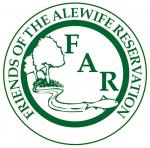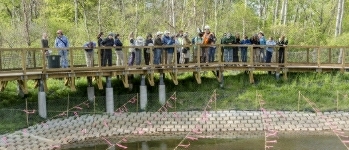Where’s the Lorax when you need him?
The trees have something to say to us.
I am a Lorax, one of many Loraxes, who speak for the trees as we listen to them in our studies and meanderings. My last name loosely interpreted means ‘essence of the forest’. We speak for other plants, birds, mammals, insects and all the creatures great and small, including humans that inhabit and love the Silver Maple Forest (SMF). We stand as one tribe of Loraxes,, we dissipated beings who share heart and soul space and a common connection to the SMF- Nature that is so dear to us. The Lorax message gained from listening, exploring, and discussing, is clear. To build on the Silver Maple Forest in Cambridge and Belmont would be akin to the last Truffula tree falling and the Brown Barbaloots disappearing in Dr. Seuss’s prescient tale many of us know and love. And so would disappear the Great-horned Owls, herons, and a vast diversity of other SMF and Alewife Reservation inhabitants, creatures great and small interconnected into the Alewife ecosystem fabric, along with the wealth of ecological services, not the least of which include carbon dioxide abatement, flood control, and much needed natural open space for people and habitat for our nonhuman kin. Unless.... For over a decade we neighbors and Friends of Alewife have been trying to stop the development of the SMF, with walks, protests, rallies, vigils, spiritual ceremonies, testimonies and statements, meetings and forums of all kinds, fundraisers, concerts, artwork, and yet the development is likely to happen despite the will of so many thousands who live near the forest. How can this be? Could we donate or sell the land and call it O’Neill Reservation. A hero would be born.
Let’s get this straight. We are Homo sapiens sapiens, brilliant creatures. We named ourselves so. As we work collectively to understand our planet and our place, we should know better. Here’s what we do know in the science field: As the world and especially the US becomes urbanized (80% of Americans live in cities, and more than 50% do so globally), natural green space increases greatly in importance, especially as one of the two most densely populated cities in New England (Cambridge), and in the Boston Basin landscape that is more than 72% paved. Also, when the urban wild green space is located at a hub of human transit, making it accessible for study, enjoyment, service, education, and nature therapy. We know about ecosystem services. These services more than justify keeping the SMF intact, and they are more than services; they connect us: carbon sequestration, flood control, temperature moderation and pollution abatement, etc., all supported by biodiversity in ecological action, the direct of experience of which is invaluable to human health, but not in the calculus for the development.
Plants and insects and other creatures engaged in complex and exquisite networks of mutualism tell us that the SMF is a living system that plays a vital role in our lives, with us as part of it as much as it is part of us. Why don’t we see it? Development is all around the SMF. Do we need more Lorax story thneeds in place of Cambridge’s last precious urban wild? I am certainly not negating or minimizing the importance of housing, but the overall quality of life of tens of thousands of people who live in the region now would be diminished if the forest were built upon. This Lorax says ‘shame on you’ if ‘you’ let this happen.
As a scientist-and-educator-Lorax, I am struck by the rapid surge in awareness of the outdoor nature movement amidst this age of urbanization. Nature is speaking to us, and we are trying to get more of it in our lives. Nature – the SMF, with its proximity to Alewife Reservation - is important for normal development, helping to treat ‘Nature Deficit Disorder’.
The scientific evidence is powerful that immersion in nature, and things like bird song have neuro-restorative and powerful positive psychological, developmental, and physical effects, including things like boosting self-esteem, reducing domestic violence rates, stimulating emotional centers of the brain giving us cognitive relief from our fast paced lives, enhancing social skills, and even lowering systolic blood pressure while raising NK cell counts and other compounds that fight cancer and boost our immune system. The secondary compounds released by trees likely cause these latter effects (which last for a month after the experience) simply by our breathing and walking slowly in the forest. Thus do the trees speak to us, as we speak for them.
Given these benefits, from the usual larger scale essential ecosystem services to the now known to be essential more direct human individual and group benefits of an intact SMF, how could one, a few, or many, in good conscience, destroy the dear SMF, so wonderfully situated where it is, in a crowded and ever more paved cityscape, and especially in a region known for its intellectual capital and social progressiveness? What’s more, the forest is where the Great Swamp’s southern border used to be. Perhaps that is why there is so much biodiversity there; it may be in the deep memories of the wild creatures that inhabit it. It is where William Brewster, father of American ornithology, used to explore. It has a distinctly Walden like feel because of this important socio-ecological history. It’s one reason the place draws me in and mesmerizes me with its wonders. Recent research articles about the loss of birds over the past 150 years in Cambridge show that it happens block by block. When will it stop? We are playing with fire metaphorically and with climate, flood, health, biodiversity, knowledge, and happiness literally.
If the SMF is ‘developed’ with a large residential building, more than just trees will be cut. History will be lost, along with forest future, and a little patch of natural darkness at night for us to enjoy a precious sense of greatness of the night sky. Those who have never even visited or heard about the SMF will be affected directly and indirectly, as will the myriad rich diversity of humanity that has come to know the Greater Alewife Ecosystem. We are all Loraxes, and there are more of us than you might imagine, and we will feel the blades and excavators, down deep to our souls because we feel and know in our hearts , minds and bodies that we are right. We will cry and mourn for the loss of our kin and the SMF, but not before standing before the destroyers. Unless.......
- Home
- Directions
- FAR Wildlife Blog
- Calendar
- News
- Donate Now
- Get Social!
- Storm Water Wetlands
- Plants and Restoration
- Photos
- Videos
- About & Projects
- Master Plan for Alewife
- Archive
- Newsletters
- Contact
 Presentation Spotlighting Alewife Reservation
Presentation Spotlighting Alewife Reservation
 Follow us on Twitter
Follow us on Twitter
 Like us on Facebook
Like us on Facebook
 Follow us on Instagram
Follow us on Instagram
Forward our web address to a friend!
- An Urban Gem - Alewife Reservation Nature Preserve
- Envisioning The Silver Maple Forest
- History and Policies of Cambridge, Belmont, and DEP
- Storm Water Wetlands
- Friends of Alewife Reservation brochure
(front, back) - Technical Analysis of Upper Alewife Basin
- Watershed: An Excursion in Four Parts
- The River Is A Restless Spirit: Life in the floodplain forest
-
Assessment of Silver Maple forest for DEP Adjudicatory hearings and
Patrick Fairbairn, author of the Assessment - Community Native Garden Flora
The
Alewife Reservation
is a unique natural resource for the communities of Belmont, Arlington and Cambridge
and home to hundreds of species, including hawks, coyotes beavers, snapping turtles, wild turkeys and muskrats,
the reservation is a unique natural resource for the community.
Historical information (Powerpoint)
Friends of Alewife Reservation works to protect and restore this wild area and the surrounding area for the water quality, native plants, animals and over 90 bird species with paths for walking, running and biking, recreation, and for classroom education and research. We regularly steward and preserve the Reservation area for wildlife and for the enjoyment of present and future generations.

(video)
By-Laws
About Friends of Alewife Reservation
Statement of Purpose
Citizen Forester newsletter archive
The Birds of the Cambridge Region of Massachusetts

by William Brewster 1906
Nuttal Ornithological Society
Biodiversity Study of Alewife Reservation Area: Species, Habitat, Ecosystems

Inventories by David Brown, wildlife assessor (2003, 2004.) Published by and available from FAR for $10. Write or call for your copy. (sample)
Updated Dave Brown Inventories (2008, 2010)
Inventories of Alewife Reservation Wetland Plants by Walter Kittredge, Botanist (2013)
Email: alewife@greencambridge.org
Join our mailing list
For technical problems with this website, email: webmaster@friendsofalewifereservation.org

